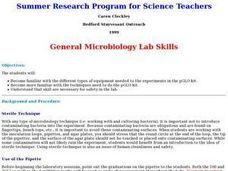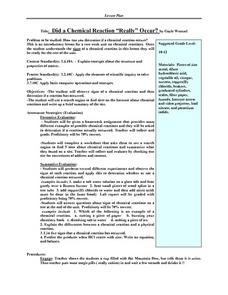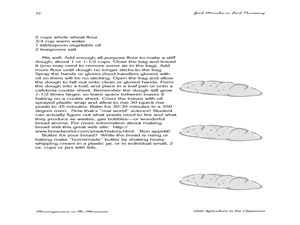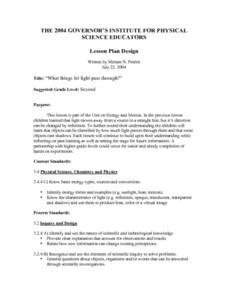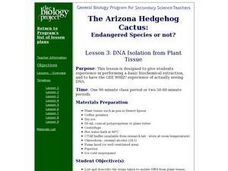Curated OER
Is It There?
Students participate in a lesson designed to illustrate these concepts using simple materials. They use Science process skills to observe, measure, predict, make inferences, and communicate while completing the activity. Proper safety...
Curated OER
Water Filtering
Students investigate how polluted water is filtered so people can use this recycled resource. They conduct an experiment in which they put "polluted" water through a filtering system. They investigate what happens at a water treatment...
Curated OER
Where in the World is Carbon Dixoide?
Students conduct experiments designed to detect the presence of CO2 by using a BTB that changes color (blue to yellow) in the presence of CO2. First, students experiment with the CO2 from combining vinegar and baking soda. In part two,...
Curated OER
One Plus One Makes New
Students discover the properties of matter and how they change when composite materials are produced. For this informative lesson students write up a question and procedure to an experiment then analyze and draw conclusions based...
Curated OER
Be a Watershed - Create a Living River
Students investigate water ways by conducting an experiment with classmates. In this natural resources lesson, students define a watershed and identify where large ones are located within the United States. Students utilize...
Curated OER
General Microbiology Lab Skills
High schoolers study the different types of equipment necessary for the experiments in the pGLO kit. They examine the techniques and safety procedures for working with the kit.
Curated OER
Genetic Engineering
Students are introduced to the concept of genetic engineering. In groups, they participate in a variety of experiments, in which they analyze the effect of chemicals on different substances. Using the internet, they research gossypol,...
Curated OER
Did a Chemical Reaction "Really" Occur?
Students perform several different experiments to observe signs of chemical reactions and determine if reaction has occurred, use search engine to find Internet sites pertaining to chemical reactions, and write up brief summary of site.
Curated OER
Active Wear
Learners interpret and analyze data. In this middle school mathematics lesson, students conduct an experiment in which they investigate which solar collector, black, white, or silver, absorbs the most heat. Learners examine...
Curated OER
No Impact Project: Water
Students use the "No Impact Project" to analyze the consumption of water. In this water consumption lesson, students discuss the pros and cons of tap water or bottled water. Students read about chemicals in water and watch a video clip...
Curated OER
I Need Air
Pupils examine and research the organs of the respiratory system. They participate in a vocabulary card matching game, create a graphic organizer, and participate in an experiment titled, Floating on Air.
Curated OER
Systems Working Together
Fourth graders practice reading in the content areas (science) in order to explore the interdependence of the body systems. They answer written questions after reading.
Curated OER
Dogs & Darwin
Ninth graders construct and conduct a laboratory experiment illustrating the transfer of mutations. They compare and contrast natural selection in organisms with long and short reproductive cycles.
Curated OER
Pill Bug Extravaganza
Tenth graders watch a PowerPoint presentation to review the scientific process. They examine pill bugs before designing an experiment to find new discoveries about these Crustaceans. They complete ten lessons in this unit.
Curated OER
Where The Wild Things Are
Twelfth graders brainstorm where they think wild things exist. Then using the same strategy they discuss natural surroundings from using prior life experience. This part of the lesson can also be done with using a nature hike. Students...
Curated OER
What Are Caves All About?
Students explore materials within their science group and figure out what they can be used for. They also contribute in a group discussion about stalactites and stalagmites and create their own stalactite using the materials given to...
Curated OER
Good Microbes in Food Processing
Students participate in a bread making experiment to understand the good microbes in bread. In this bread making activity, students prepare bread in a bag with varied recipes and note results.
Curated OER
DNA: The Search for the Genetic Material
Young scholars study the history of DNA and how to extract it. In this genetic lesson plan students complete a DNA experiment using bacteria.
Curated OER
Density and Buoyancy Lesson Plan
Students investigate why some objects float or sink in water. In this physics activity, students calculate the density of clay ball using a mathematical equation. They write a complete lab report about the experiment.
Curated OER
Collaboration via Slime Mold
Students combine the skills and concepts that they have developed to ask a simple question which can be answered on a Petri plate. They ask questions and design experiments for verification through collaboration with their classmates.
Curated OER
What things let Light Pass Through?
Second graders classify objects according to how well light can pass through them and predict how well objects will transmit light. They experiment with objects to verify predictions while collecting, recording, and interpreting data...
Curated OER
Enzyme Activity: An Inquiry Based Approach
Using an inquiry approach to studying biochemical reactions, cooperative teams of learners investigate hypotheses about living materials that contain enzymes which break down in hydrogen peroxide. They perform experiments, practice...
Curated OER
DNA Isolation from Plant Tissue
Students perform an experiment to extract and observe DNA from plant Tissue. They read about the procedure and relate it to the procedure used to isolate DNA from an endangered plant species. This is lesson three in a nine lesson unit...
Curated OER
Using Microscopes
Young scholars do an experiment using a microscope. In this lesson, about cells, students examine different slides using a microscope. Young scholars look at an onion skin, cheek cells, and potato cells. In each of these, students find...





